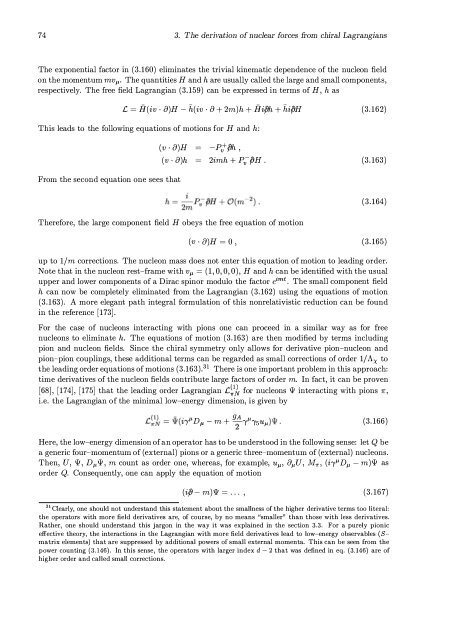The Nucleon-Nucleon Interaction in a Chiral Effective Field Theory
The Nucleon-Nucleon Interaction in a Chiral Effective Field Theory
The Nucleon-Nucleon Interaction in a Chiral Effective Field Theory
Create successful ePaper yourself
Turn your PDF publications into a flip-book with our unique Google optimized e-Paper software.
74 3. <strong>The</strong> derivation o{ nuc1ear {orces {rom chiral Lagrangians<br />
<strong>The</strong> exponential faetor <strong>in</strong> (3.160) elim<strong>in</strong>ates the trivial k<strong>in</strong>ematic dependenee of the nucleon field<br />
on the moment um mvw <strong>The</strong> quantities H and h are usually ealled the large and small eomponents,<br />
respeetively. <strong>The</strong> free field Lagrangian (3.159) ean be expressed <strong>in</strong> terms of H, h as<br />
.c = fI(iv . ö)H - h(iv . ö + 2m)h + fIi�h + hi�H<br />
This leads to the follow<strong>in</strong>g equations of motions for H and h:<br />
(v · ö)H<br />
(v . ö)h<br />
From the second equation one sees that<br />
-Pv+�h ,<br />
2imh + Pv - �H .<br />
<strong>The</strong>refore, the large eomponent field H obeys the free equation of motion<br />
(v · ö)H = 0 ,<br />
(3.162)<br />
(3.163)<br />
(3.164)<br />
(3.165)<br />
up to l/m eorreetions. <strong>The</strong> nucleon mass does not enter this equation of motion to lead<strong>in</strong>g order.<br />
Note that <strong>in</strong> the nucleon rest-frame with vJ.l = (1,0, 0,0), H and h ean be identified with the usual<br />
upper and lower eomponents of a Dirae sp<strong>in</strong>or modulo the faetor eimt. <strong>The</strong> small eomponent field<br />
h ean now be eompletely elim<strong>in</strong>ated from the Lagrangian (3.162) us<strong>in</strong>g the equations of motion<br />
(3.163). A more elegant path <strong>in</strong>tegral formulation of this nonrelativistie reduetion ean be found<br />
<strong>in</strong> the referenee [173].<br />
For the ease of nucleons <strong>in</strong>teraet<strong>in</strong>g with pions one ean proeeed <strong>in</strong> a similar way as for free<br />
nucleons to elim<strong>in</strong>ate h. <strong>The</strong> equations of motion (3.163) are then modified by terms <strong>in</strong>clud<strong>in</strong>g<br />
pion and nucleon fields. S<strong>in</strong>ee the ehiral symmetry only allows for derivative pion-nucleon and<br />
pion-pion eoupl<strong>in</strong>gs, these additional terms ean be regarded as small eorrections of order 1/ Ax to<br />
the lead<strong>in</strong>g order equations ofmotions (3.163).31 <strong>The</strong>re is one important problem <strong>in</strong> this approach:<br />
time derivatives of the nucleon fields eontribute large factors of order m. In fact, it ean be proven<br />
[68], [174], [175] that the lead<strong>in</strong>g order Lagrangian .cS 1 Jv for nucleons 'l1 <strong>in</strong>teract<strong>in</strong>g with pions 7r,<br />
Le. the Lagrangian of the m<strong>in</strong>imal low-energy dimension, is given by<br />
r(l) _ ,1" ( ' J.l D<br />
9A J.I ) 'T'<br />
'-'7rN - 'i' n J.I - m + TI' I' 5 UJ.l 'i'. (3.166)<br />
Here, the low-energy dimension of an operator has to be understood <strong>in</strong> the follow<strong>in</strong>g sense: let Q be<br />
a generic four-momentum of (external) pions or a generie three-momentum of (external) nucleons.<br />
<strong>The</strong>n, U, 'l1, DJ.I'l1, m count as order one, whereas, for example, uJ.l ' öJ.lU, M7r , (i--y J.l DJ.I - m)'l1 as<br />
order Q. Consequently, one ean apply the equation of motion<br />
(i�- m)'l1 = ... , (3.167)<br />
31 Clearly, one should not understand this statement ab out the smallness of the higher derivative terms too literal:<br />
the operators with more field derivatives are, of course, by no means "smaller" than those with less derivatives.<br />
Rather, one should understand this jargon <strong>in</strong> the way it was expla<strong>in</strong>ed <strong>in</strong> the section 3.3. For a purely pionic<br />
effective theory, the <strong>in</strong>teractions <strong>in</strong> the Lagrangian with more field derivatives lead to low-energy observables (8matrix<br />
elements) that are suppressed by additional powers of small external momenta. This can be seen from the<br />
power count<strong>in</strong>g (3.146). In this sense, the operators with larger <strong>in</strong>dex d - 2 that was def<strong>in</strong>ed <strong>in</strong> eq. (3.146) are of<br />
higher order and called small corrections.












